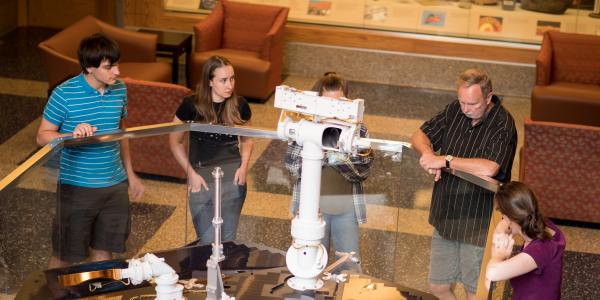Mars: From Warm and Wet to Cold and Dry as Shown During the Curiosity Rover’s Ascent of Mount Sharp
Spacecraft flyby and orbital observations of Mars provide extensive morphologic evidence for ancient dendritic fluvial systems, deltas, lakes, massive breakout channels due to melting ground ice, and volcanoes indicative of explosive interaction between ground water and magma. The Spirit and Opportunity rovers that touched down in 2004 provided “boots on the ground” observations of the ancient rock records preserved in Gusev Crater and Meridiani Planum. The observations demonstrated that the cold, dry Mars of today was once warm and wet, supporting extensive surface and subsurface water bodies.
These two rovers were followed by Curiosity, which landed in 2012 on the plains within Gale Crater, next to Mount Sharp, a five kilometer high stack of layered sedimentary rocks. Orbital spectroscopic and imaging observations indicate that the lowest and thus oldest rock layers exposed on Mount Sharp contain an abundance of phyllosilicates. The middle layers are dominated by evaporitic sulfate-bearing rocks, and the top, and thereby youngest rocks, are dominated by wind-blown deposits.
Since landing, Curiosity has been ascending Mount Sharp, acquiring data that effectively spans the time when Mars went from warm and wet to cold and dry. In fact, Curiosity landed on fluvial gravels, and as the rover ascended the lowest part of the stratigraphic column found evidence for fluvial, deltaic, and lacustrine deposits, replete with extensive smectites and organic compounds. The data conclusively show that an ancient lake filled Gale Crater. Currently the rover is located just below what has been inferred from orbital observations to be the strata dominated by evaporitic rocks. Initial observations indicate a transition from a fluvial-lacustrine depositional environment to one consisting of thick sections of wind-blown sandstones (dunes) interbedded with ephemeral lake deposits. Within a few months the rover’s further ascent should place Curiosity within the putative evaporitic rock deposits.
During the lecture we will cover the evidence accumulated by Curiosity that shows the transition from warm, wet to cold, dry conditions for the red planet.
The talk will be preceded by an open house showcasing many of the department's laboratories from 1:30 p.m. to 3:30 p.m. in Rudolph Hall. A reception will follow the talk at 5 p.m. in Knight Hall. The nearest parking for Rudolph Hall is the East End Garage and Millbrook Garage for Knight Hall.

